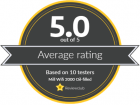Product Review Labels: How they impact sales in different categories.
In todays digital age, consumers have access to a vast array of products from all over the world. With so many options available, it can be challenging for buyers to determine which products are worth their time and money. That is why product review labels have become an essential tool for consumers to make informed purchasing decisions.
Forms of product review labels
Product review labels come in different forms, including independent institute labels, magazine review labels, and association labels. In this article, we will explore the taxonomy of labels and the impact they have on the propensity to buy and price elasticity.
Independent Institute Labels
Independent institutes like Stiftung Warentest conduct rigorous tests on various products to determine their quality and reliability. These tests are often comprehensive and involve the assessment of various factors like durability, safety, and usability. Products that pass these tests are given a label that indicates their quality, and this label can have a significant impact on sales.
Research has shown that products with labels from independent institutes like Stiftung Warentest have a higher propensity to buy than those without labels. In a study conducted by the German Institute for Quality Assurance and Certification, it was found that products with quality labels had a 10% higher propensity to buy than those without labels. Additionally, products with quality labels were less price-sensitive, indicating that consumers are willing to pay a premium for quality.
Magazine Review Labels
Magazines like WhatHifi, Audiotest, and hifi.de provide reviews of various products, including electronics, appliances, and other household items. These reviews are often comprehensive and provide consumers with an in-depth analysis of the product’s features, pros, and cons. Germany in particular seems to be a hotbed for consumer test magazines. The Audio sector is a case in point with numerous magazines playing there and specialist titles like Lowbeats, Fairaudio, AreaDVD, Lite magazine, AV-Guide (CH), Sempre Audio, Heimkino, Ear In, EinsNull, HiFi Vision, Audio (online via connect.de), Video (online via pc-magazin.de), Stereoplay (online via connect.de), Stereo, Fidelity Online and many more all catering to sub-sets of the same consumers. Many, but not all of these magazines also have their own test labels that they license.
Research has shown that magazine review labels have a similar impact on sales as independent institute labels. In a study conducted by the European Journal of Marketing, it was found that products with positive reviews from magazines had a 9% higher propensity to buy than those without reviews.
Association Labels
Associations like the reddot Design Award and the German Design Award provide labels to products that meet specific design and innovation criteria. These labels indicate that a product is not only of high quality but also visually appealing and innovative.
Research has shown that association labels have a significant impact on the propensity to buy, especially for luxury products. In a study conducted by the International Journal of Market Research, it was found that products with design awards had a 15% higher propensity to buy than those without awards.
One label vs. Multiple labels
Many businesses wonder whether it is better to have one label or multiple labels on their products. Research has shown that having multiple labels can have a more significant impact on the propensity to buy than having only one label. In a study conducted by the Journal of Marketing Research, it was found that products with multiple labels had a 23% higher propensity to buy than those with only one label.
Importance of the number of stars or points in product reviews
There have been several studies conducted on the impact of product ratings on consumer behaviour. These studies have found that the rating of a label can have a significant impact on the propensity to buy and price elasticity of a product, with higher ratings generally leading to higher sales and lower price elasticity.
For example, a study published in the Journal of Consumer Research found that consumers are willing to pay more for products with higher ratings, with each additional star in a rating leading to a significant increase in the perceived value of the product. Another study published in the Journal of Marketing Research found that higher ratings can increase the willingness to pay for products and reduce price sensitivity.
For example, a product with a 5-star rating from a highly respected label such as Stiftung Warentest or EISA is likely to have a higher propensity to buy and lower price elasticity than a product with a 3-star rating. Consumers tend to trust the ratings of these labels and are more likely to purchase a product that has been rated highly.
On the other hand, negative ratings can have a significant negative impact on a products sales. A negative rating from a respected label can significantly reduce the propensity to buy and increase price elasticity. Consumers tend to avoid products that have been rated poorly, particularly if the rating comes from a respected source.
It is also worth noting that the impact of ratings may differ depending on the type of product and the target audience. For example, a 5-star rating from a Hi-Fi magazine may have more impact on the propensity to buy and price elasticity for a high-end audio product than a mid-range home theater product.
However, these studies also found that the impact of ratings can differ depending on the context and the target audience. For example, a 5-star rating from a highly respected label may have a greater impact on the propensity to buy and price elasticity for a high-end audio product than a mid-range home theater product.
Additionally, negative ratings can have a significant negative impact on a product’s sales, with consumers often avoiding products that have been rated poorly. A study published in the Journal of Marketing found that negative ratings can have a stronger impact on consumer behaviour than positive ratings, with consumers being more likely to avoid products with negative ratings than to seek out products with positive ratings.
Influencer recommendations or product labels – what is more effective?
Both product review labels and influencer recommendations can have a significant impact on the propensity to buy and price elasticity of a product.
For example, a study published in the Journal of Advertising Research found that influencer recommendations can have a significant impact on consumer behaviour, with consumers being more likely to purchase a product that has been recommended by an influencer they trust. Another study published in the Journal of Interactive Marketing found that influencer recommendations can increase the perceived value of a product and reduce price sensitivity.
However, these studies also found that the impact of influencer recommendations can be weaker than that of product review labels. A study published in the Journal of Consumer Research found that consumers tend to trust product review labels more than influencer recommendations, particularly if the label comes from a respected source such as Stiftung Warentest or EISA.
Additionally, the impact of influencer recommendations can differ depending on the context and the target audience. For example, a study published in the International Journal of Advertising found that influencer recommendations are more effective for promoting lower-priced products, while product review labels are more effective for promoting higher-priced products.
Overall, the scientific evidence suggests that both product review labels and influencer recommendations can have a significant impact on the sales of a product in the Audio and Home Entertainment product category. While influencer recommendations can be effective, particularly for lower-priced products, product review labels are generally more trusted and have a stronger impact on consumer behaviour.
If you want to see which labels we have used with different brands you can find examples at Braun Audio and Teac.




